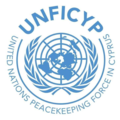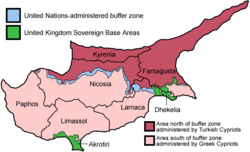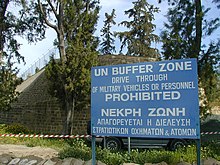United Nations Buffer Zone in Cyprus
This article needs additional citations for verification. (July 2012) |
 | |
 The UN Buffer Zone is shown in light blue on the map. | |
| Formation | 4 March 1964 |
|---|---|
| Type | Demilitarized zone |
Special Representative | Elizabeth Spehar |
Commander | Maj. Gen. Ingrid Margrethe Gjerde |
Parent organization | United Nations Peacekeeping Force in Cyprus |
The United Nations Buffer Zone in Cyprus is a demilitarized zone, patrolled by the United Nations Peacekeeping Force in Cyprus (UNFICYP), that was established on 4 March 1964, then extended on 9 August after the Battle of Tillyria and extended again in 1974 after the ceasefire of 16 August 1974, following the Turkish invasion of Cyprus, and the de facto partition of the island into the area controlled by the Republic of Cyprus (excluding the British Sovereign Base Areas) and the largely unrecognized Turkish Republic of Northern Cyprus in the north. The zone, also known as the Green Line (Greek: Πράσινη Γραμμή, Prasini Grammi; Turkish: Yeşil Hat), stretches for 180 kilometres (112 miles) from Paralimni in the east to Kato Pyrgos in the west, where a separate section surrounds Kokkina.
The dividing line is also referred to as the Attila Line,[1] named after Turkey's 1974 military intervention, codenamed Operation Attila. The Turkish army has built a barrier on the zone's northern side, consisting mainly of barbed-wire fencing, concrete wall segments, watchtowers, anti-tank ditches, and minefields. The zone cuts through the centre of Nicosia, separating the city into southern and northern sections. In total, it spans an area of 346 square kilometres (134 sq mi), varying in width from less than 20 metres (66 ft) to more than 7 kilometres (4.3 mi).[2][3][4] After the fall of the Berlin Wall in 1989, Nicosia remains the last divided capital in Europe.[5][6] Some 10,000 people live in several villages and work on farms located within the zone; the village of Pyla is famous for being one of the few remaining villages in Cyprus where Greek and Turkish Cypriots still live side by side. Other villages are Deneia, Athienou, and Troulloi. Some areas are untouched by human interference and have remained a safe haven for flora and fauna.[3]
History




A buffer zone in Cyprus was first established in the last days of 1963, when Major-General
This map was then passed to General Young's intelligence officer, who was waiting in a nearby building and told to "Get on with it." [by whom?] Intelligence Corps NCOs then copied the map for distribution to the Truce Force units. Further copies of the map would then have been produced 'in house' for use by Truce Force patrols.[9]
The Green Line became impassable following the July 1974
A security zone of a size to be determined by representatives of Greece, Turkey, and the United Kingdom, in consultation with UNFICYP, was to be established at the limit of the areas occupied by the Turkish armed forces. This zone was to be entered by no forces other than those of UNFICYP, which was to supervise the prohibition of entry. Pending the determination of the size and character of the security zone, the existing area between the two forces was not to be breached by any forces.
— Tripartite Conference & Geneva Declaration, [11]
The UN Security Council then adopted the above declaration with
Traffic across the buffer zone was very limited until 2003, when the number of crossings and the rules governing them were relaxed.[citation needed]
In March 2021 Cyprus erected a barbed wire fence on the Buffer Zone to curb illegal immigration.[12]
Sectors
Sector One
Starts at Kokkina exclave and covers approximately 90 kilometres (55 mi) to Mammari, west of Nicosia. Since 16 October 1993, it has been the responsibility of the Argentinian Contingent with approximately 212 soldiers. Sector One Headquarters and Command Company are located in San Martin Camp, which is near Skouriotissa village. Support Company finds its home at Roca Camp, near Xeros in the north. The two line companies are deployed along four permanently staffed patrol bases while also conducting mobile patrols from the San Martin and Roca camps.[13]
Sector Two
Starts at Mammari, west of Nicosia and covers 30 kilometres (20 mi) to Kaimakli, east of Nicosia. Since 1993, it has been the responsibility of the British contingent, which deploys using the name Operation TOSCA.[14]
Sector Three
Sector 3 was patrolled by Canadian troops until their departure in 1993. It was then absorbed into Sectors 2 and 4.[15]
Sector Four
Starting at
Crossings

After a nearly 30-year ban on crossings, the Turkish Cypriot administration significantly eased travel restrictions across the dividing line in April 2003, allowing Greek Cypriots to cross at the
These are the crossings now available:
| Cyprus area under the control of the Republic of Cyprus | Cyprus area under the control of Northern Cyprus | Notes |
|---|---|---|
| Astromeritis (Αστρομερίτης) | Zodeia (Ζώδεια, Bostancı) | By car only |
| Ayios Dhometios (Άγιος Δομέτιος) | Metehan | By foot and car |
| Ledra Palace | Ledra Palace | By foot only |
| Ledra Street (οδός Λήδρας, Lokmacı Caddesi) | Ledra Street (οδός Λήδρας, Lokmacı Caddesi) | By foot only |
| Pyla (Πύλα, Pile) |
Pergamos (Πέργαμoς, Beyarmudu) | |
| Agios Nikolaos (Άγιος Νικόλαος) | Strovilia (Akyar) | Crossing point controls carried out by SBA police on the one side, and by the police of the de facto Turkish Republic of Northern Cyprus on the other side |
| Limnitis (Λιμνίτης, Yeşilırmak) | Limnitis (Λιμνίτης, Yeşilırmak) | |
| Deryneia (Δερύνεια, Derinya) | Famagusta (Αμμόχωστος, Gazimağusa) | |
| Aplic (Οδόφραγμα Λεύκας, Aplic) | Lefka (Λεύκα, Lefke) |
Before Cypriot accession to the
Incidents
On 11 August 1996, Greek Cypriots demonstrated with a march against the
Another man,
In August 2023, de facto Turkish security forces (police and military) attacked members of the U.N. peacekeeping force inside the U.N. buffer zone at the
Activism
The buffer zone between the checkpoints that divide Ledra Street was used as a space for activism from 15 October 2011 up until June 2012 by the Occupy Buffer Zone movement.[27]
See also
- Cyprus conflict
- Cypriot refugees
- Republic of Cyprus
- United Nations High Commissioner for Refugees Representation in Cyprus
- List of territories governed by the United Nations
- Sovereign Base Areas Customs
- Pyla
- Louroujina Salient
- Kokkina exclave
References
- ^ Oxford References: Attila Line
- ^ "UNFICYP Background". UN.org. UN Peacekeeping. Retrieved 10 March 2016.
- ^ a b "About the Buffer Zone". unficyp.unmissions.org. United Nations Peacekeeping Force in Cyprus. 20 November 2015. Retrieved 10 March 2016.
- ^ Konyalian, Claudia. "Biodiversity in Cyprus 346 square kilometres Buffer Zone". undp.org. United Nations Development Programme. Retrieved 10 March 2016.
- ^ Associated Press: 30 years after the Berlin Wall, Cyprus' division endures
- ^ Independent.co.uk: Europe's other wall: How militarised barrier continues to divide Cyprus, 30 years after Berlin's came down
- ^ Jon Calame and Esther Charlesworth, Divided Cities: Belfast, Beirut, Jerusalem, Mostar, and Nicosia (University of Pennsylvania Press, 2011) p133
- ^ Obituary, The Times, 16 July 1994
- ^ Interview with Brigadier Michael Perrett-Young (General Young's Intelligence Officer) and Captain Christopher Meynell (General Young's ADC)
- ^ "UNSC Resolution 353 (1974)" (PDF). United Nations. 20 July 1974. Archived from the original (PDF) on 22 April 2014. Retrieved 4 July 2012.
- ^ "Tripartite Conference & Geneva Declaration". United Nations Peacekeeping Force in Cyprus. Retrieved 20 April 2024.
- ^ Smith, Helena (18 March 2021). "Cyprus rebuked for 'violent' pushbacks of boats carrying asylum seekers". The Guardian. Retrieved 7 April 2021.
- ^ "Sector One". UNFICYP. 30 April 2008. Archived from the original on 17 February 2012. Retrieved 4 July 2012.
- ^ "Sector Two". UNFICYP. 30 April 2008. Archived from the original on 17 February 2012. Retrieved 4 July 2012.
- ^ "BB_Jan_Feb_2013 | Peacekeeping | United Nations". www.scribd.com. Archived from the original on 9 August 2020.
- ^ "Sector Four". UNFICYP. 30 April 2008. Archived from the original on 17 February 2012. Retrieved 4 July 2012.
- ISBN 9789756194348.
- ^ "Consolidated version of the Green Line Regulation including amendments" (PDF) (PDF). Council of the European Union. 17 February 2005. Archived from the original (PDF) on 4 February 2007.
- ^ Euirpoean Commission (14 July 2005). "2. Crossing of Persons" (PDF). Report on the implementation of Council Regulation (EC) 866/2004 of 29 April 2004 and the situation resulting from its application. COM. Vol. (2005) 320 final. Brussels. p. 3.
{{cite book}}: CS1 maint: location missing publisher (link) - ^ Amnesty International Report 1997 - Cyprus. Amnesty International Publications. 1997. Retrieved 16 January 2013.
In August, Tasos Isaak, a Greek Cypriot, was beaten to death in the UN buffer zone by Turkish Cypriots or alleged members of the Turkish organization Grey Wolves. Video footage showed a Turkish Cypriot police officer watching Tasos Isaac being beaten without intervening. Violence erupted when Greek Cypriots protesting against the division of Cyprus tried to force their way through the buffer zone. Tasos Isaak was beaten unconscious, while UN peacekeepers nearby watched, with clubs and stones after becoming trapped in barbed-wire barricades. He died soon afterwards from severe head injuries.
- ^ "1 killed, 11 wounded as Turks shoot at Greek Cypriots armed with stones". Associated Press. 15 August 1996. Retrieved 29 October 2007.
- ^ Kessel, Jerrold (15 August 1996). "Cyprus conflict comes to a boil, U.N., U.S. fault Turkey for Greek Cypriot deaths". CNN. Archived from the original on 27 March 2007.
- ^ Christou, Jean (11 November 1997). "Denktash 'minister' on Interpol list over Solomou killing". Cyprus Mail. Retrieved 4 July 2012.
- ^ "UN peacekeepers hurt in Cyprus buffer zone clash with Turkish forces". reuters. Archived from the original on 19 August 2023.
- ^ "Erdoğan slams UN peacekeepers for blocking road project in Turkish Cyprus". Archived from the original on 22 August 2023.
- ^ "U.N. calls unauthorized construction by Turkish Cypriots a violation of the status quo on Cyprus". Archived from the original on 22 August 2023.
- ^ "Cypriots #OccupyBufferZone". The Stream. AlJazeera. 15 November 2011. Archived from the original on 8 April 2013. Retrieved 4 July 2012.
External links
- UNFICYP website
- Forgotten Architecture in the United Nations Buffer Zone Cyprus Adrian Scarbrough Photography

